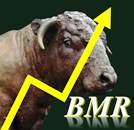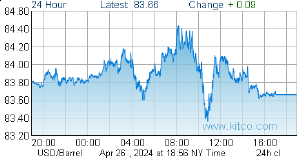HAPPY EASTER!
CDNX and Gold
The CDNX snapped a 7-session losing streak with a 29-point gain Wednesday and followed that up with a 19-point jump Thursday for a weekly loss of only 9 points. The Index closed Thursday at its rising 100-day moving average (SMA) of 2282. The 7-session drop, from the April 11 intra-day high of 2400 to the April 19 intra-day low of 2221, amounted to 179 points or 7.5%. This was a minor correction compared to the 17% drop we saw over 7 sessions in March. As John outlined in his most recent CDNX chart last Monday, the Index has very strong support at 2200.
Throughout this bull market, which started in late 2008, the winning strategy with the CDNX has been to embrace these pullbacks as opposed to selling into them out of fear. As the old saying goes, buy into weakness and sell into strength. Many investors have not disciplined their minds in that way and often do the opposite. The horrific 2008 Market Crash still lingers in the minds of many which is one reason why the masses have still not piled into the CDNX, but that time will come. It’s extremely important to stay focused on the “big picture” and understand that we’re in a long-term bull market that remains completely intact based on technical and fundamental factors. In our view this is the best time ever to hold shares in high quality junior Gold stocks with the price of Gold expected to continue to climb. From a broader perspective, the global demand for resources in general is going to fuel this CDNX bull run for several more years at least but not without some corrections (minor and major) and pauses of course along the way. The primary trend is up.
Gold powered past the psychologically important $1,500 level last week, closing at $1,508 for a gain of $22. The catalyst for the move to $1,500 and higher appeared to be last Monday’s downgrading of the long-term debt outlook for the United States to negative by Standard and Poor’s which said it believes there’s a risk U.S. policymakers may not reach agreement on how to address the country’s fiscal pressures. The S&P announcement was no great surprise – we all know the U.S. is in a fiscal mess – and it was just a warning, not an actual lowering of the U.S. debt rating which was affirmed at AAA, the highest level possible. Nonetheless, S&P has raised the urgency of the issue and has given politicians “cover” to make some difficult choices in the weeks and months ahead.
It’s important to point out also that not only is Washington on a very slippery financial slope but so too are many U.S. states and cities. Governments all over the world, Canada included, have been engaging in excessive and dangerous spending for far too long (while Canada’s federal public debt to GDP may be the lowest in the developed world, when you add in provincial debts – guaranteed by Ottawa – the ratio is scary. A year from now, Ontario and Quebec alone will owe more than Ottawa or half a trillion dollars). “Big Government” goes completely against what the American founding fathers envisioned and they were right. The coming austerity measures required in the United States, Canada and Europe are going to be painful but necessary.
Which brings us to Fed Chairman Ben Bernanke’s next steps (the FMOC meets Tuesday and Wednesday with Bernanke holding an unprecedented news conference Wednesday). The wisdom of “quantitative easing” can certainly be questioned but what matters to investors is what’s going through Bernanke’s mind right now and whether or not he’ll end “QE2”, which has been a boon for Gold and commodities across the board, as scheduled in June. Our thinking, for what it’s worth, is that “QE3” in some form or other is just around the corner. Bernanke has consistently stated he doesn’t see inflation as a threat at the moment. Given the coming austerity measures in the United States, stubbornly high unemployment and a housing crisis that has simply not bottomed out yet, the last thing Bernanke is about to do is suddenly turn off the monetary stimulus taps and take actions or say anything that would endanger the “wealth effect” of rising markets. He may be setting the United States up for inflationary troubles down the road but he’d rather have inflation than deflation. Bernanke has given all of us great opportunities to make bucket loads of money in speculative junior resource stocks over the past two-and-a-half years and we don’t believe that’s about to change.
As far as Gold is concerned, John’s January prediction of $1,650 by June is looking more likely by the day. Has Gold gotten ahead of itself? Not at all. Below is an interesting chart, going back 10 years, that shows that Gold’s move over the past 60 days is within the normal band of volatility, up about 7% over that time period. There’s certainly plenty of room for Gold to move higher over the coming weeks which gives further credence to the yellow metal reaching the $1,650 level as early as June.
 Silver, however, has traveled into extreme territory and for that reason could cool off somewhat in the near future. At the moment Silver seems determined to take a run at its all-time high of just over $50 an ounce set in January, 1980. For the week Silver was up another $3.63 an ounce to $46.08. Ultimately during this bull cycle, $100 Silver or more seems highly likely.
Silver, however, has traveled into extreme territory and for that reason could cool off somewhat in the near future. At the moment Silver seems determined to take a run at its all-time high of just over $50 an ounce set in January, 1980. For the week Silver was up another $3.63 an ounce to $46.08. Ultimately during this bull cycle, $100 Silver or more seems highly likely.
The fundamental case for Gold remains incredibly strong – currency instability and an overall lack of confidence in fiat currencies, an environment of historically low interest rates and negative real interest rates (inflation is greater than the nominal interest rate even in parts of the world where rates are increasing), massive government debt from the United States to Europe, central bank buying, flat mine supply, physical demand, investment demand, emerging market growth, geopolitical unrest and conflicts, rising oil prices, inflation concerns…the list goes on. It’s hard to imagine Gold not performing well in this environment. The Middle East is being turned on its head and that could ultimately have major positive consequences for Gold.
For those pundits who mistakenly claim that Gold is in a “bubble”, its interesting to note that Gold ownership as a percentage of global financial assets is only 0.7% vs. 0.2% in 2002 at the beginning of the current bull cycle (a majority of that increase has been fueled by Gold’s sharp price appreciation).
As an asset class, Gold is still very much under-owned. And the “masses” still haven’t piled into Gold stocks. We’re not even close to a bubble in Gold.
A fascinating and important development reported a week ago was the University of Texas endowment fund taking physical delivery of $1 billion of Gold (this amounts to about 5% of its total assets).
“The role Gold plays in our portfolio is as a hedge against currencies. The concern is that we have excess monetary and fiscal stimulus,” Bruce Zimmerman, chief executive officer of The University of Texas Investment Management Company told CNBC television.
While Zimmerman said it was easier and more economical for the fund to physically accept the Gold, which it is paying to store in a vault presumably deep below the sidewalks of New York, rather than the more usual route of buying a derivative contract, the move also must reflect concern about the risk of those contracts not being honored. To that extent the investment is not only protection against inflation and currency risk, but against market failure as well.
The University of Texas endowment fund has made a long-term investment in Gold. Look for other endowments and pension funds to do the same moving forward. Can there be any doubt Gold is headed much, much higher?
 BullMarketRun.com
BullMarketRun.com








